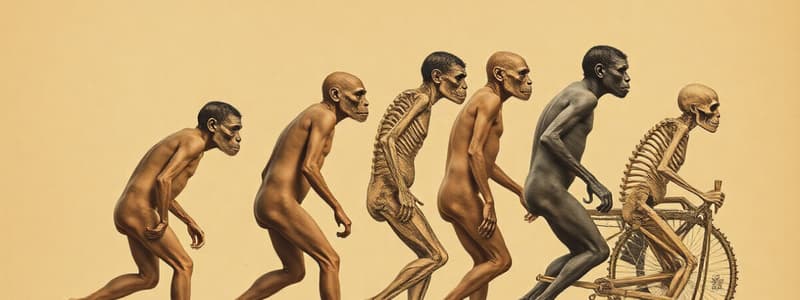Podcast
Questions and Answers
What are Australopithecines?
What are Australopithecines?
A group of hominins that lived in Africa between approximately 4 million and 2 million years ago, known for their bipedalism and both human-like and ape-like traits.
Who is Lucy?
Who is Lucy?
A famous Australopithecine fossil discovered in 1974, classified as Australopithecus afarensis, estimated to be about 3.2 million years old.
What is Sahelanthropus?
What is Sahelanthropus?
An early hominin species that lived about 7 million years ago, possibly one of the oldest known human ancestors.
What is the superfamily that includes humans and their closest relatives?
What is the superfamily that includes humans and their closest relatives?
What are Hominoids?
What are Hominoids?
What are Anthropoids?
What are Anthropoids?
What is the family classification that includes humans?
What is the family classification that includes humans?
What is the genus that includes modern humans?
What is the genus that includes modern humans?
What are Hominines?
What are Hominines?
What are the primary characteristics of Australopithecines?
What are the primary characteristics of Australopithecines?
When did the first hominids appear and where are they thought to have originated?
When did the first hominids appear and where are they thought to have originated?
What is the relationship between Australopithecines and later hominids?
What is the relationship between Australopithecines and later hominids?
When did humans begin to walk upright?
When did humans begin to walk upright?
What is bipedalism?
What is bipedalism?
What are some key physiological changes associated with bipedalism?
What are some key physiological changes associated with bipedalism?
How does bipedalism affect the pelvic region?
How does bipedalism affect the pelvic region?
In what way does bipedalism limit the size of the infant?
In what way does bipedalism limit the size of the infant?
What major geological events define seismic change?
What major geological events define seismic change?
During which epoch did hominoids primarily evolve?
During which epoch did hominoids primarily evolve?
What do LCA and MRCA stand for in evolutionary terms?
What do LCA and MRCA stand for in evolutionary terms?
What is the time frame of the Pliocene Epoch, and what significant developments occurred?
What is the time frame of the Pliocene Epoch, and what significant developments occurred?
What characterized the Pleistocene Epoch?
What characterized the Pleistocene Epoch?
What is Sahelanthropus tchadensis, and what does its name mean?
What is Sahelanthropus tchadensis, and what does its name mean?
What evidence exists regarding bipedalism in Sahelanthropus tchadensis?
What evidence exists regarding bipedalism in Sahelanthropus tchadensis?
Where was Sahelanthropus tchadensis discovered?
Where was Sahelanthropus tchadensis discovered?
What significant fossil was found for Sahelanthropus tchadensis?
What significant fossil was found for Sahelanthropus tchadensis?
What is Orrorin tugenensis, and where was it discovered?
What is Orrorin tugenensis, and where was it discovered?
Flashcards are hidden until you start studying
Study Notes
Australopithecines
- A group of early hominins that lived in Africa from 4 million to 2 million years ago.
- Known for their bipedalism (walking upright) and a mix of human-like and ape-like traits.
- Lucy, a famous Australopithecus afarensis fossil discovered in 1974, is estimated to be 3.2 million years old.
Early Hominins
- Sahelanthropus, an early hominin species that lived about 7 million years ago, may be one of the oldest known human ancestors.
Human Evolutionary Relationships
- Hominoidea: Superfamily that includes humans and their closest relatives (apes).
- Hominoids: Family of primates that includes all apes (great and lesser) and humans.
- Anthropoids: Suborder of primates that includes monkeys, apes, and humans.
- Hominidae (hominids): Family that includes humans.
- Homo: Genus that encompasses all human species, including Homo sapiens.
- Hominines: Subfamily of Hominidae that includes humans and their closest relatives, such as chimpanzees and bonobos.
Bipedalism
- The defining characteristic of humans, walking upright on two legs.
- Began with hominids, as evidenced by the Leakey footprints, which date back at least 3.4 million years.
- Requires significant adaptations in the skeletal structure, muscle arrangement, and balance for efficient upright movement.
- Changes in pelvic structure result in a shorter, wider pelvis to support upright walking and stabilize the body.
- The narrower birth canal created by the pelvic changes limits the size of human infants for easier childbirth.
Geological Events and Epochs
- Major geological events that shaped human evolution include: continental plate shifts, the drying up of Central Africa, India's northward movement, and the formation of the Himalayas.
- Hominoids primarily evolved during the Miocene Epoch.
- LCA (Last Common Ancestor) and MRCA (Most Recent Common Ancestor) are terms used in evolutionary studies to refer to ancestral lineages.
- The Pliocene Epoch (5 to 1.8 million years ago) saw the evolution of early hominids.
- The Pleistocene Epoch (1.8 million to 12,000 years ago) was marked by repeated Ice Ages.
Sahelanthropus tchadensis
- Also known as "Toumai," it lived around 6-7 million years ago.
- Its name means "hope of life."
- Discovered in Northern Chad.
- A nearly complete skull has been found.
- There is no definitive proof of bipedalism in this species.
Orrorin tugenensis
- Discovered in Kenya, dating between 5.6 and 6.2 million years ago.
- Fossil discoveries include a femur and mandible, suggesting some evidence of bipedalism.
Studying That Suits You
Use AI to generate personalized quizzes and flashcards to suit your learning preferences.





